Audit Planning Report: BAO3306 Assignment for Kneomedia Limited Audit
VerifiedAdded on 2022/10/06
|9
|3357
|16
Report
AI Summary
This report provides an executive summary and detailed analysis of the audit planning process for Kneomedia Limited, adhering to Australian Auditing Standards. The report focuses on the initial steps required when auditing a company for the first time, emphasizing the auditor's responsibility in expressing an opinion on the financial statements' true and fair view to stakeholders. It highlights the importance of effective audit planning, including gaining an understanding of the client, identifying significant accounts at risk of material misstatement, and setting the planning materiality level. The report analyzes the impact of various auditing standards, such as ASA 210, ASA 220, ASA 230, and ASA 250, on the audit planning process. It identifies and discusses five significant accounts from Kneomedia Limited's 2018 annual report that are at risk of material misstatement, providing explanations for the identified risks. The analysis includes a focus on revenue, cash and cash equivalents, finance costs, and share-based payment expenses, demonstrating the application of auditing standards in practice. The report concludes by summarizing the key aspects of audit planning and its importance in ensuring reliable and transparent audit processes.
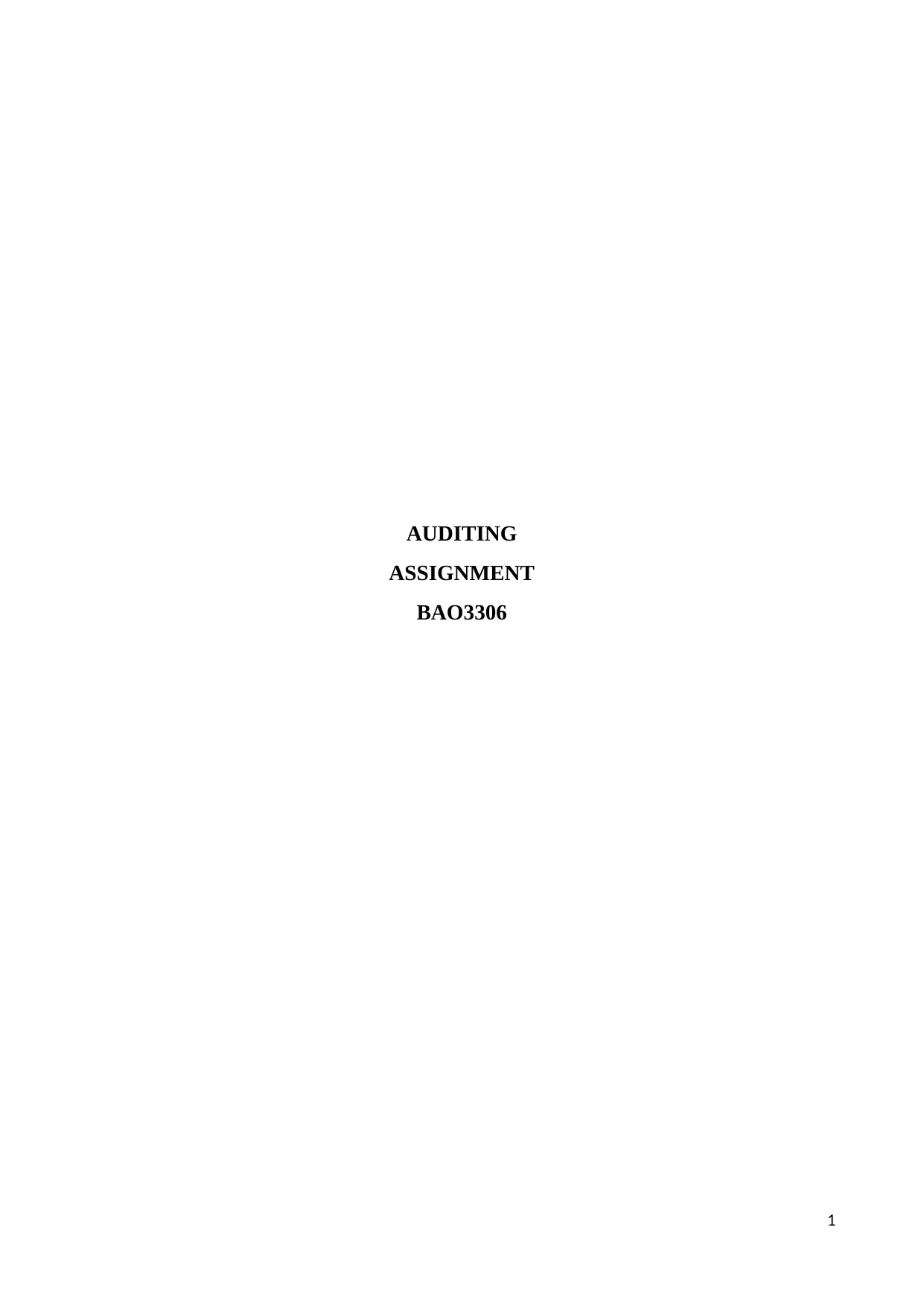
AUDITING
ASSIGNMENT
BAO3306
1
ASSIGNMENT
BAO3306
1
Paraphrase This Document
Need a fresh take? Get an instant paraphrase of this document with our AI Paraphraser
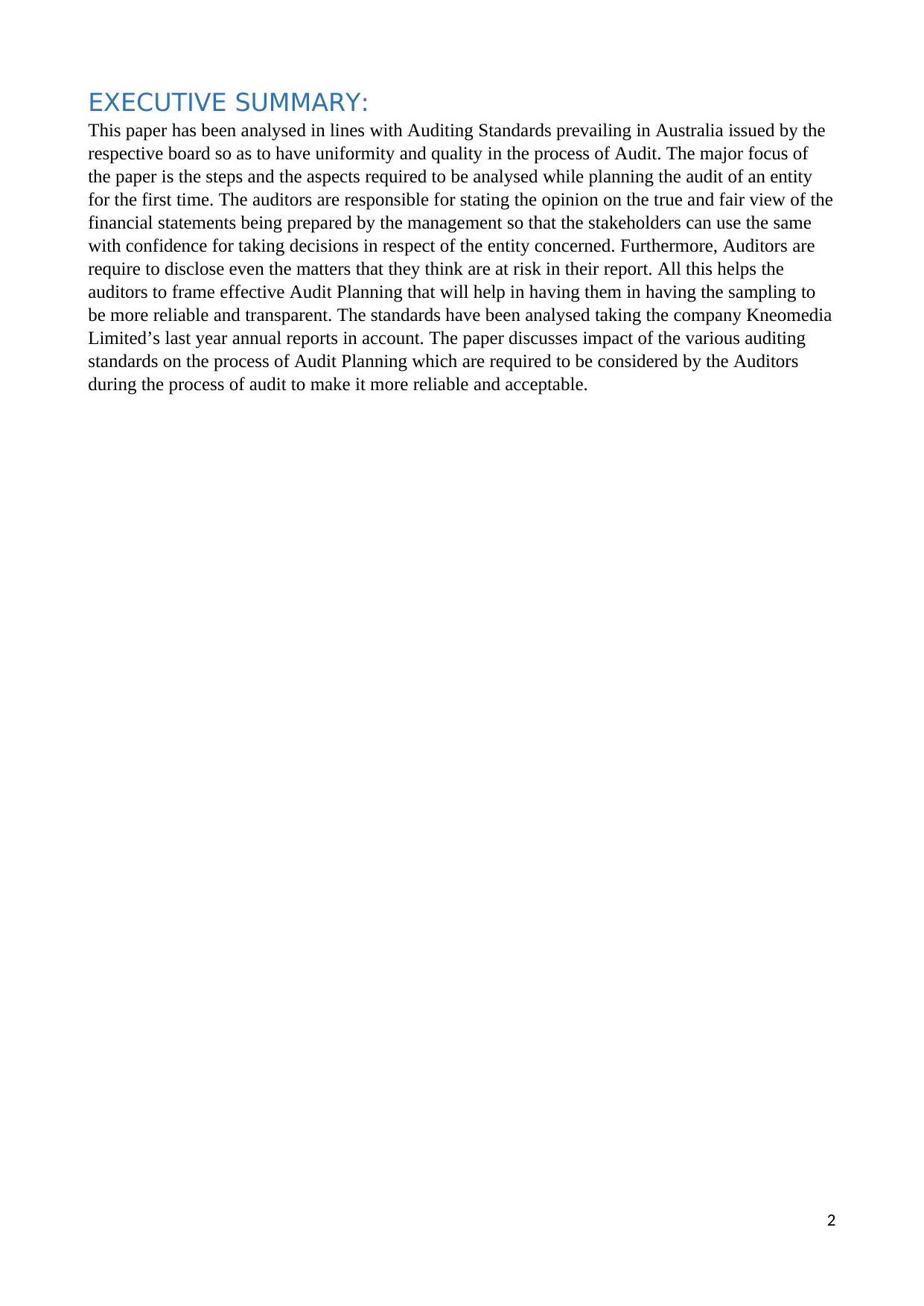
EXECUTIVE SUMMARY:
This paper has been analysed in lines with Auditing Standards prevailing in Australia issued by the
respective board so as to have uniformity and quality in the process of Audit. The major focus of
the paper is the steps and the aspects required to be analysed while planning the audit of an entity
for the first time. The auditors are responsible for stating the opinion on the true and fair view of the
financial statements being prepared by the management so that the stakeholders can use the same
with confidence for taking decisions in respect of the entity concerned. Furthermore, Auditors are
require to disclose even the matters that they think are at risk in their report. All this helps the
auditors to frame effective Audit Planning that will help in having them in having the sampling to
be more reliable and transparent. The standards have been analysed taking the company Kneomedia
Limited’s last year annual reports in account. The paper discusses impact of the various auditing
standards on the process of Audit Planning which are required to be considered by the Auditors
during the process of audit to make it more reliable and acceptable.
2
This paper has been analysed in lines with Auditing Standards prevailing in Australia issued by the
respective board so as to have uniformity and quality in the process of Audit. The major focus of
the paper is the steps and the aspects required to be analysed while planning the audit of an entity
for the first time. The auditors are responsible for stating the opinion on the true and fair view of the
financial statements being prepared by the management so that the stakeholders can use the same
with confidence for taking decisions in respect of the entity concerned. Furthermore, Auditors are
require to disclose even the matters that they think are at risk in their report. All this helps the
auditors to frame effective Audit Planning that will help in having them in having the sampling to
be more reliable and transparent. The standards have been analysed taking the company Kneomedia
Limited’s last year annual reports in account. The paper discusses impact of the various auditing
standards on the process of Audit Planning which are required to be considered by the Auditors
during the process of audit to make it more reliable and acceptable.
2
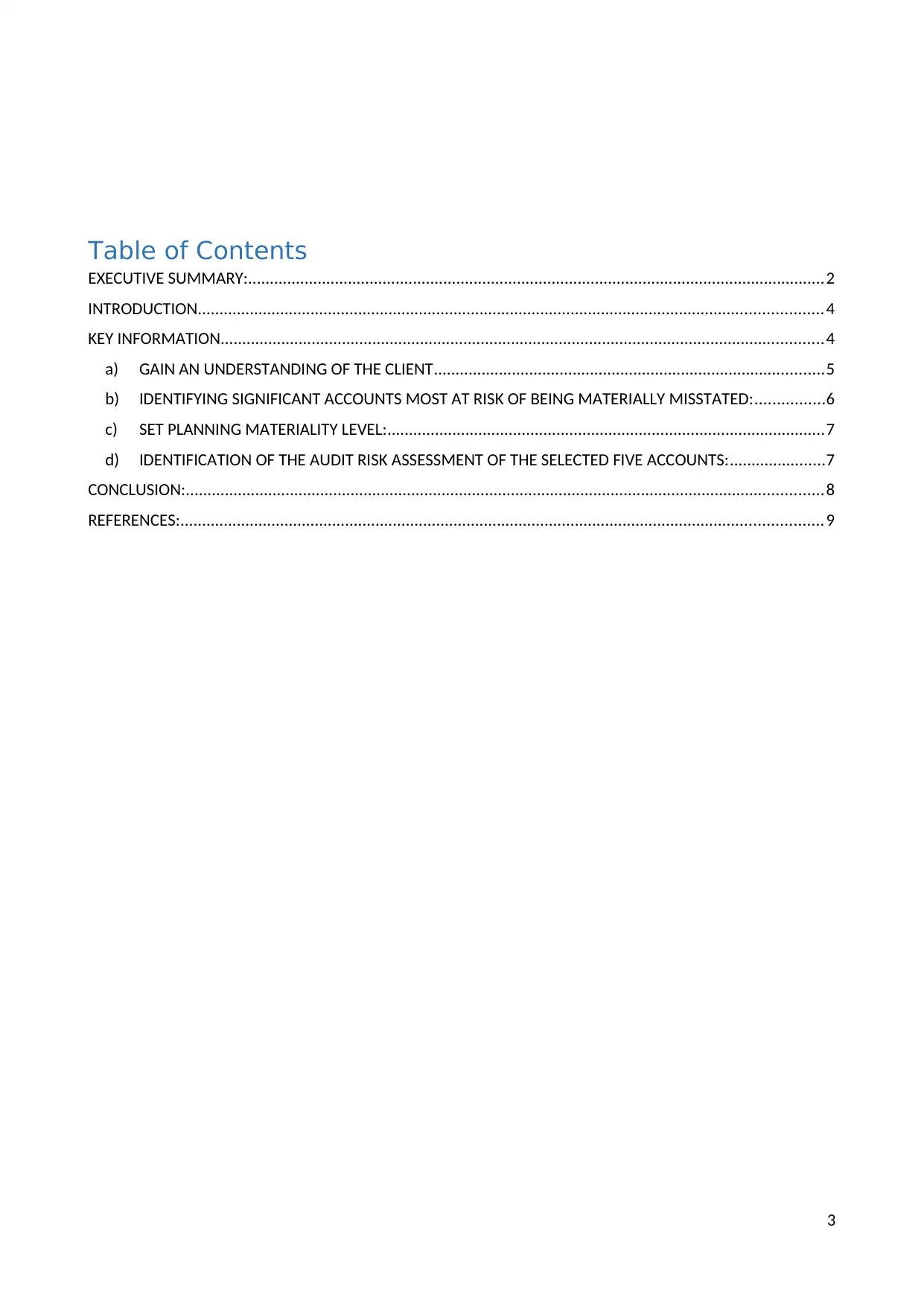
Table of Contents
EXECUTIVE SUMMARY:.....................................................................................................................................2
INTRODUCTION................................................................................................................................................4
KEY INFORMATION...........................................................................................................................................4
a) GAIN AN UNDERSTANDING OF THE CLIENT..........................................................................................5
b) IDENTIFYING SIGNIFICANT ACCOUNTS MOST AT RISK OF BEING MATERIALLY MISSTATED:................6
c) SET PLANNING MATERIALITY LEVEL:.....................................................................................................7
d) IDENTIFICATION OF THE AUDIT RISK ASSESSMENT OF THE SELECTED FIVE ACCOUNTS:......................7
CONCLUSION:...................................................................................................................................................8
REFERENCES:....................................................................................................................................................9
3
EXECUTIVE SUMMARY:.....................................................................................................................................2
INTRODUCTION................................................................................................................................................4
KEY INFORMATION...........................................................................................................................................4
a) GAIN AN UNDERSTANDING OF THE CLIENT..........................................................................................5
b) IDENTIFYING SIGNIFICANT ACCOUNTS MOST AT RISK OF BEING MATERIALLY MISSTATED:................6
c) SET PLANNING MATERIALITY LEVEL:.....................................................................................................7
d) IDENTIFICATION OF THE AUDIT RISK ASSESSMENT OF THE SELECTED FIVE ACCOUNTS:......................7
CONCLUSION:...................................................................................................................................................8
REFERENCES:....................................................................................................................................................9
3
⊘ This is a preview!⊘
Do you want full access?
Subscribe today to unlock all pages.

Trusted by 1+ million students worldwide

INTRODUCTION
Auditing is a very vital process which involves examination of the books of accounts prepared by
the management and expression of opinion on the true and fair view of the books by the auditor.
Therefore, Auditors plays a very crucial role in the financial world as because their opinion on the
genuineness of the books of the companies acts as a reference and decision making documents for
the stakeholders (Best, 2001). Therefore, there is a need for independence of the auditor and it is
expected from the auditor that he will conduct the audit efficiently. Further, accepting audit of new
client requires enhanced control procedures by the Auditors that includes the following aspects:
• Asking the right questions: The auditor is required to ask the right questions with respect to
the business of the client. This is the first step which helps in creating a relationship.
• Selectivity: The auditor is required to select the audit crucially. They are needed to analyse
the ethical movements of the clients.
• Performing Due Diligence: The auditors should perform due diligence on the prospective
client’s i.e. reasonable steps shall be taken by the auditor to avoid any fraud or misrepresentation.
Once the auditor has assessed the above mentioned parameters he is required to plan his audit
procedure. The planning of audit in a specific way and under a specific guideline while conducting
an audit is called as Audit Planning. Audit planning helps the auditor in the following ways:
• Evidences can be obtained that are sufficient
• Audit costs can be reduced by way of effective planning
• Misunderstanding with the client can be avoided.
In case of Kneomedia Limited., the firm are being approached by the management of the company
for the financial audit. Since the audit is being conducted for the first time by the firm, the firm shall
crucially examine and follow the standard process before taking up the Audit. The firm is required
to ask question from the key personnel of the company. The questions should be such that helps in
building a relationship in between firm and the key management personnel of the company. The
firm shall then select the key areas that requires special attention and is required to perform due
diligence on the clients business. The firm is also required to plan its audit effectively so as to
minimise the time and the cost of audit.
KEY INFORMATION
There is requirement on part of the external auditor to collect and gather all the key information in
relation to the entity whose audit would be conducted by them so that they can make policies for
their Audit effectively. Appropriate Audit Planning helps the firm to get the audit done smoothly.
The key information required to be gathered by the Auditor prior to the start of audit includes
gathering of information so as to have understanding of the entity whose audit will be conducted.
Furthermore, the auditors sets the materiality level and identifies accounts that have a risk of
material misstatement. All this helps in making the process of Audit smooth and reduces the risks of
ignorance of material misstatement (Simnett, 2016). Along with the identification of the accounts
that are at risk of material misstatement they should state the risk assessment of the accounts
selected.
The Key Information have been discussed herewith below.
4
Auditing is a very vital process which involves examination of the books of accounts prepared by
the management and expression of opinion on the true and fair view of the books by the auditor.
Therefore, Auditors plays a very crucial role in the financial world as because their opinion on the
genuineness of the books of the companies acts as a reference and decision making documents for
the stakeholders (Best, 2001). Therefore, there is a need for independence of the auditor and it is
expected from the auditor that he will conduct the audit efficiently. Further, accepting audit of new
client requires enhanced control procedures by the Auditors that includes the following aspects:
• Asking the right questions: The auditor is required to ask the right questions with respect to
the business of the client. This is the first step which helps in creating a relationship.
• Selectivity: The auditor is required to select the audit crucially. They are needed to analyse
the ethical movements of the clients.
• Performing Due Diligence: The auditors should perform due diligence on the prospective
client’s i.e. reasonable steps shall be taken by the auditor to avoid any fraud or misrepresentation.
Once the auditor has assessed the above mentioned parameters he is required to plan his audit
procedure. The planning of audit in a specific way and under a specific guideline while conducting
an audit is called as Audit Planning. Audit planning helps the auditor in the following ways:
• Evidences can be obtained that are sufficient
• Audit costs can be reduced by way of effective planning
• Misunderstanding with the client can be avoided.
In case of Kneomedia Limited., the firm are being approached by the management of the company
for the financial audit. Since the audit is being conducted for the first time by the firm, the firm shall
crucially examine and follow the standard process before taking up the Audit. The firm is required
to ask question from the key personnel of the company. The questions should be such that helps in
building a relationship in between firm and the key management personnel of the company. The
firm shall then select the key areas that requires special attention and is required to perform due
diligence on the clients business. The firm is also required to plan its audit effectively so as to
minimise the time and the cost of audit.
KEY INFORMATION
There is requirement on part of the external auditor to collect and gather all the key information in
relation to the entity whose audit would be conducted by them so that they can make policies for
their Audit effectively. Appropriate Audit Planning helps the firm to get the audit done smoothly.
The key information required to be gathered by the Auditor prior to the start of audit includes
gathering of information so as to have understanding of the entity whose audit will be conducted.
Furthermore, the auditors sets the materiality level and identifies accounts that have a risk of
material misstatement. All this helps in making the process of Audit smooth and reduces the risks of
ignorance of material misstatement (Simnett, 2016). Along with the identification of the accounts
that are at risk of material misstatement they should state the risk assessment of the accounts
selected.
The Key Information have been discussed herewith below.
4
Paraphrase This Document
Need a fresh take? Get an instant paraphrase of this document with our AI Paraphraser
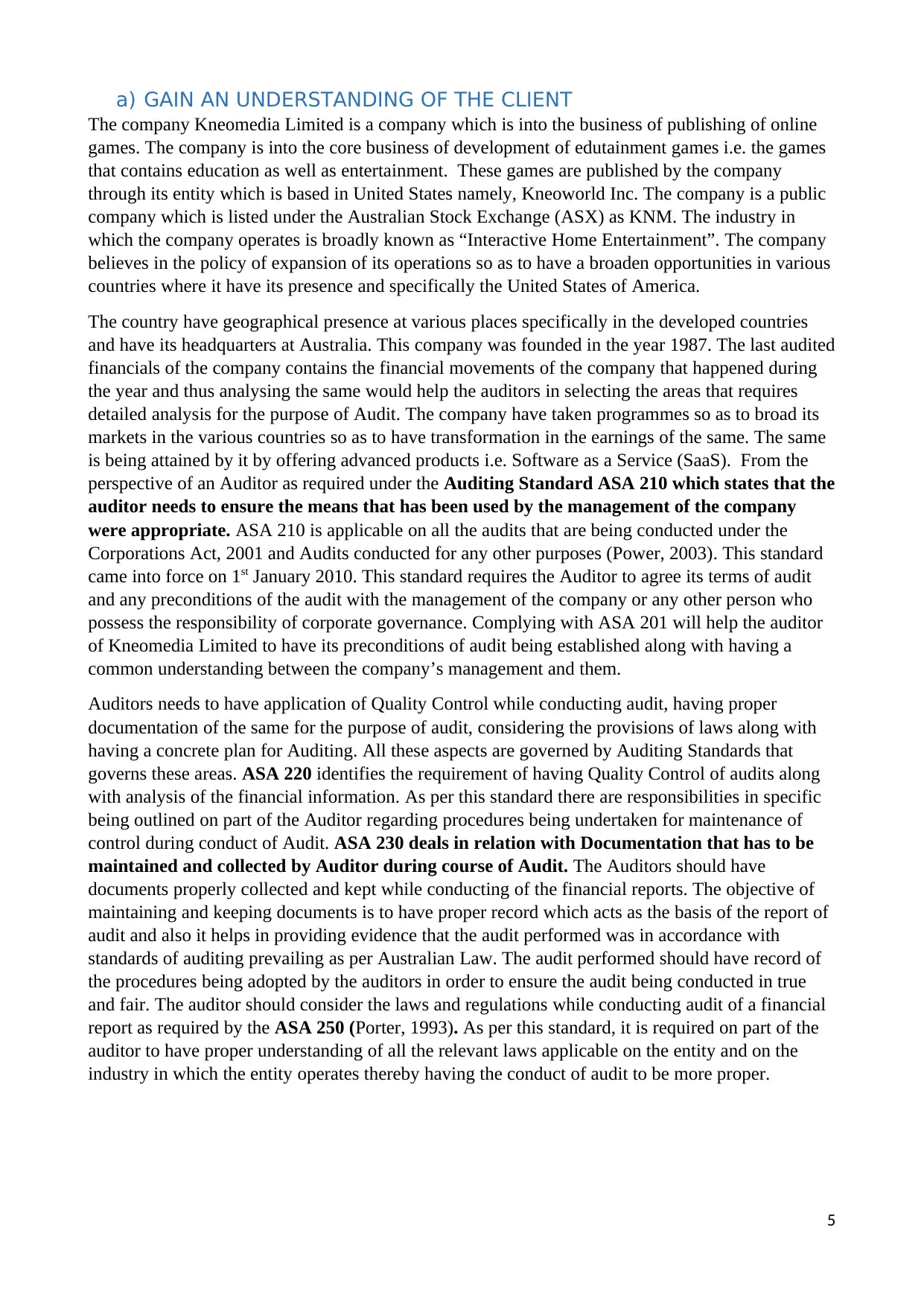
a) GAIN AN UNDERSTANDING OF THE CLIENT
The company Kneomedia Limited is a company which is into the business of publishing of online
games. The company is into the core business of development of edutainment games i.e. the games
that contains education as well as entertainment. These games are published by the company
through its entity which is based in United States namely, Kneoworld Inc. The company is a public
company which is listed under the Australian Stock Exchange (ASX) as KNM. The industry in
which the company operates is broadly known as “Interactive Home Entertainment”. The company
believes in the policy of expansion of its operations so as to have a broaden opportunities in various
countries where it have its presence and specifically the United States of America.
The country have geographical presence at various places specifically in the developed countries
and have its headquarters at Australia. This company was founded in the year 1987. The last audited
financials of the company contains the financial movements of the company that happened during
the year and thus analysing the same would help the auditors in selecting the areas that requires
detailed analysis for the purpose of Audit. The company have taken programmes so as to broad its
markets in the various countries so as to have transformation in the earnings of the same. The same
is being attained by it by offering advanced products i.e. Software as a Service (SaaS). From the
perspective of an Auditor as required under the Auditing Standard ASA 210 which states that the
auditor needs to ensure the means that has been used by the management of the company
were appropriate. ASA 210 is applicable on all the audits that are being conducted under the
Corporations Act, 2001 and Audits conducted for any other purposes (Power, 2003). This standard
came into force on 1st January 2010. This standard requires the Auditor to agree its terms of audit
and any preconditions of the audit with the management of the company or any other person who
possess the responsibility of corporate governance. Complying with ASA 201 will help the auditor
of Kneomedia Limited to have its preconditions of audit being established along with having a
common understanding between the company’s management and them.
Auditors needs to have application of Quality Control while conducting audit, having proper
documentation of the same for the purpose of audit, considering the provisions of laws along with
having a concrete plan for Auditing. All these aspects are governed by Auditing Standards that
governs these areas. ASA 220 identifies the requirement of having Quality Control of audits along
with analysis of the financial information. As per this standard there are responsibilities in specific
being outlined on part of the Auditor regarding procedures being undertaken for maintenance of
control during conduct of Audit. ASA 230 deals in relation with Documentation that has to be
maintained and collected by Auditor during course of Audit. The Auditors should have
documents properly collected and kept while conducting of the financial reports. The objective of
maintaining and keeping documents is to have proper record which acts as the basis of the report of
audit and also it helps in providing evidence that the audit performed was in accordance with
standards of auditing prevailing as per Australian Law. The audit performed should have record of
the procedures being adopted by the auditors in order to ensure the audit being conducted in true
and fair. The auditor should consider the laws and regulations while conducting audit of a financial
report as required by the ASA 250 (Porter, 1993). As per this standard, it is required on part of the
auditor to have proper understanding of all the relevant laws applicable on the entity and on the
industry in which the entity operates thereby having the conduct of audit to be more proper.
5
The company Kneomedia Limited is a company which is into the business of publishing of online
games. The company is into the core business of development of edutainment games i.e. the games
that contains education as well as entertainment. These games are published by the company
through its entity which is based in United States namely, Kneoworld Inc. The company is a public
company which is listed under the Australian Stock Exchange (ASX) as KNM. The industry in
which the company operates is broadly known as “Interactive Home Entertainment”. The company
believes in the policy of expansion of its operations so as to have a broaden opportunities in various
countries where it have its presence and specifically the United States of America.
The country have geographical presence at various places specifically in the developed countries
and have its headquarters at Australia. This company was founded in the year 1987. The last audited
financials of the company contains the financial movements of the company that happened during
the year and thus analysing the same would help the auditors in selecting the areas that requires
detailed analysis for the purpose of Audit. The company have taken programmes so as to broad its
markets in the various countries so as to have transformation in the earnings of the same. The same
is being attained by it by offering advanced products i.e. Software as a Service (SaaS). From the
perspective of an Auditor as required under the Auditing Standard ASA 210 which states that the
auditor needs to ensure the means that has been used by the management of the company
were appropriate. ASA 210 is applicable on all the audits that are being conducted under the
Corporations Act, 2001 and Audits conducted for any other purposes (Power, 2003). This standard
came into force on 1st January 2010. This standard requires the Auditor to agree its terms of audit
and any preconditions of the audit with the management of the company or any other person who
possess the responsibility of corporate governance. Complying with ASA 201 will help the auditor
of Kneomedia Limited to have its preconditions of audit being established along with having a
common understanding between the company’s management and them.
Auditors needs to have application of Quality Control while conducting audit, having proper
documentation of the same for the purpose of audit, considering the provisions of laws along with
having a concrete plan for Auditing. All these aspects are governed by Auditing Standards that
governs these areas. ASA 220 identifies the requirement of having Quality Control of audits along
with analysis of the financial information. As per this standard there are responsibilities in specific
being outlined on part of the Auditor regarding procedures being undertaken for maintenance of
control during conduct of Audit. ASA 230 deals in relation with Documentation that has to be
maintained and collected by Auditor during course of Audit. The Auditors should have
documents properly collected and kept while conducting of the financial reports. The objective of
maintaining and keeping documents is to have proper record which acts as the basis of the report of
audit and also it helps in providing evidence that the audit performed was in accordance with
standards of auditing prevailing as per Australian Law. The audit performed should have record of
the procedures being adopted by the auditors in order to ensure the audit being conducted in true
and fair. The auditor should consider the laws and regulations while conducting audit of a financial
report as required by the ASA 250 (Porter, 1993). As per this standard, it is required on part of the
auditor to have proper understanding of all the relevant laws applicable on the entity and on the
industry in which the entity operates thereby having the conduct of audit to be more proper.
5
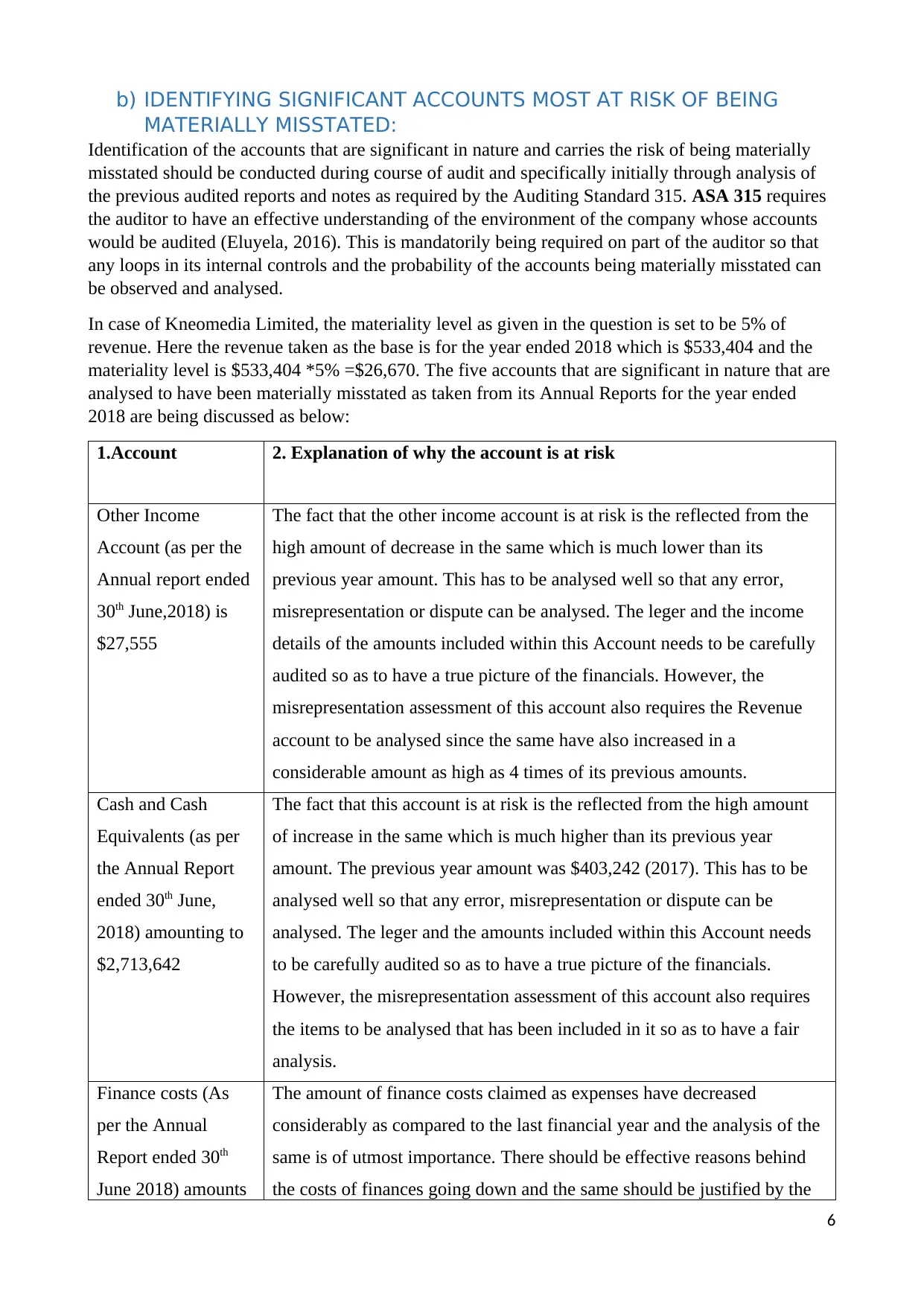
b) IDENTIFYING SIGNIFICANT ACCOUNTS MOST AT RISK OF BEING
MATERIALLY MISSTATED:
Identification of the accounts that are significant in nature and carries the risk of being materially
misstated should be conducted during course of audit and specifically initially through analysis of
the previous audited reports and notes as required by the Auditing Standard 315. ASA 315 requires
the auditor to have an effective understanding of the environment of the company whose accounts
would be audited (Eluyela, 2016). This is mandatorily being required on part of the auditor so that
any loops in its internal controls and the probability of the accounts being materially misstated can
be observed and analysed.
In case of Kneomedia Limited, the materiality level as given in the question is set to be 5% of
revenue. Here the revenue taken as the base is for the year ended 2018 which is $533,404 and the
materiality level is $533,404 *5% =$26,670. The five accounts that are significant in nature that are
analysed to have been materially misstated as taken from its Annual Reports for the year ended
2018 are being discussed as below:
1.Account 2. Explanation of why the account is at risk
Other Income
Account (as per the
Annual report ended
30th June,2018) is
$27,555
The fact that the other income account is at risk is the reflected from the
high amount of decrease in the same which is much lower than its
previous year amount. This has to be analysed well so that any error,
misrepresentation or dispute can be analysed. The leger and the income
details of the amounts included within this Account needs to be carefully
audited so as to have a true picture of the financials. However, the
misrepresentation assessment of this account also requires the Revenue
account to be analysed since the same have also increased in a
considerable amount as high as 4 times of its previous amounts.
Cash and Cash
Equivalents (as per
the Annual Report
ended 30th June,
2018) amounting to
$2,713,642
The fact that this account is at risk is the reflected from the high amount
of increase in the same which is much higher than its previous year
amount. The previous year amount was $403,242 (2017). This has to be
analysed well so that any error, misrepresentation or dispute can be
analysed. The leger and the amounts included within this Account needs
to be carefully audited so as to have a true picture of the financials.
However, the misrepresentation assessment of this account also requires
the items to be analysed that has been included in it so as to have a fair
analysis.
Finance costs (As
per the Annual
Report ended 30th
June 2018) amounts
The amount of finance costs claimed as expenses have decreased
considerably as compared to the last financial year and the analysis of the
same is of utmost importance. There should be effective reasons behind
the costs of finances going down and the same should be justified by the
6
MATERIALLY MISSTATED:
Identification of the accounts that are significant in nature and carries the risk of being materially
misstated should be conducted during course of audit and specifically initially through analysis of
the previous audited reports and notes as required by the Auditing Standard 315. ASA 315 requires
the auditor to have an effective understanding of the environment of the company whose accounts
would be audited (Eluyela, 2016). This is mandatorily being required on part of the auditor so that
any loops in its internal controls and the probability of the accounts being materially misstated can
be observed and analysed.
In case of Kneomedia Limited, the materiality level as given in the question is set to be 5% of
revenue. Here the revenue taken as the base is for the year ended 2018 which is $533,404 and the
materiality level is $533,404 *5% =$26,670. The five accounts that are significant in nature that are
analysed to have been materially misstated as taken from its Annual Reports for the year ended
2018 are being discussed as below:
1.Account 2. Explanation of why the account is at risk
Other Income
Account (as per the
Annual report ended
30th June,2018) is
$27,555
The fact that the other income account is at risk is the reflected from the
high amount of decrease in the same which is much lower than its
previous year amount. This has to be analysed well so that any error,
misrepresentation or dispute can be analysed. The leger and the income
details of the amounts included within this Account needs to be carefully
audited so as to have a true picture of the financials. However, the
misrepresentation assessment of this account also requires the Revenue
account to be analysed since the same have also increased in a
considerable amount as high as 4 times of its previous amounts.
Cash and Cash
Equivalents (as per
the Annual Report
ended 30th June,
2018) amounting to
$2,713,642
The fact that this account is at risk is the reflected from the high amount
of increase in the same which is much higher than its previous year
amount. The previous year amount was $403,242 (2017). This has to be
analysed well so that any error, misrepresentation or dispute can be
analysed. The leger and the amounts included within this Account needs
to be carefully audited so as to have a true picture of the financials.
However, the misrepresentation assessment of this account also requires
the items to be analysed that has been included in it so as to have a fair
analysis.
Finance costs (As
per the Annual
Report ended 30th
June 2018) amounts
The amount of finance costs claimed as expenses have decreased
considerably as compared to the last financial year and the analysis of the
same is of utmost importance. There should be effective reasons behind
the costs of finances going down and the same should be justified by the
6
⊘ This is a preview!⊘
Do you want full access?
Subscribe today to unlock all pages.

Trusted by 1+ million students worldwide
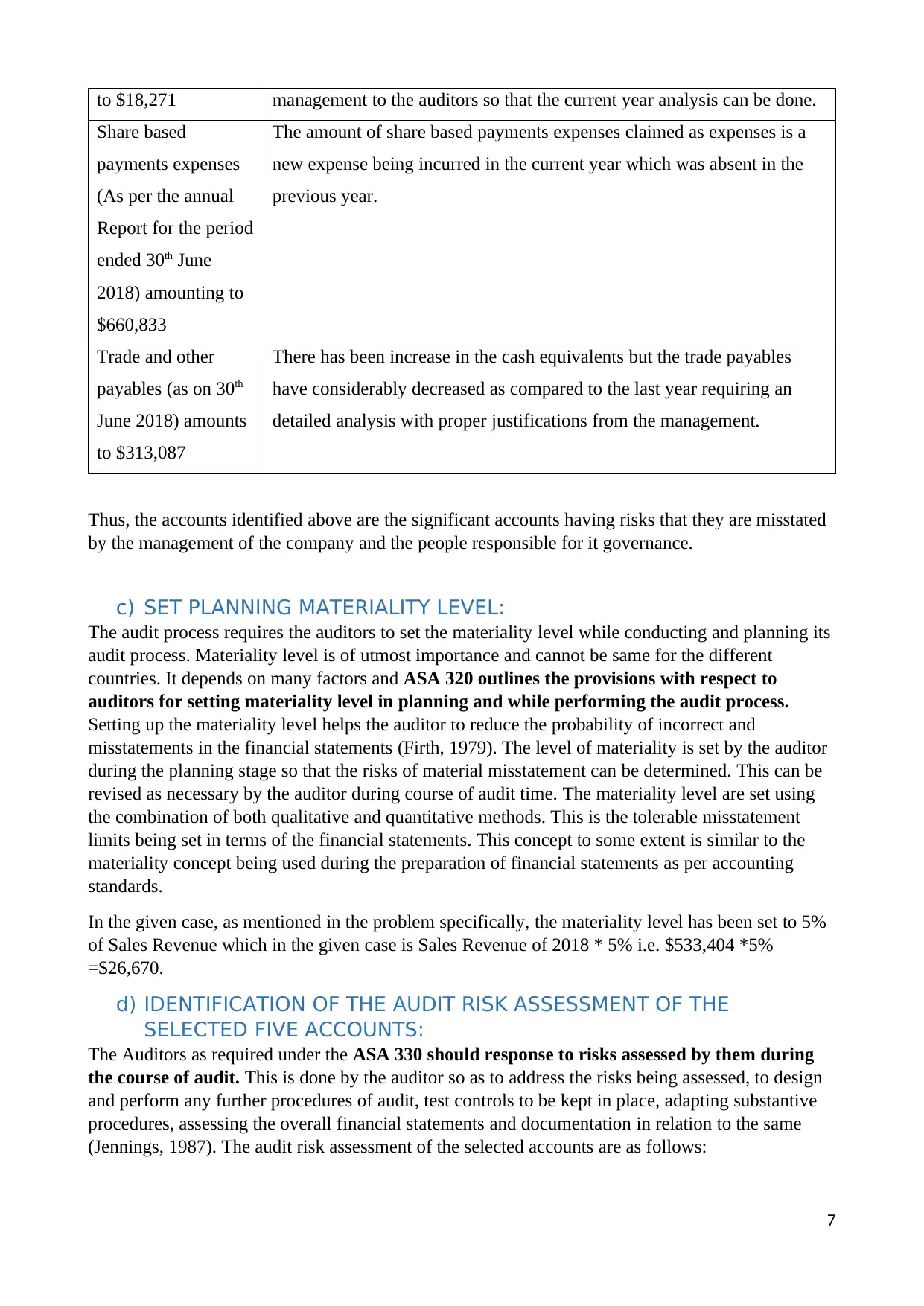
to $18,271 management to the auditors so that the current year analysis can be done.
Share based
payments expenses
(As per the annual
Report for the period
ended 30th June
2018) amounting to
$660,833
The amount of share based payments expenses claimed as expenses is a
new expense being incurred in the current year which was absent in the
previous year.
Trade and other
payables (as on 30th
June 2018) amounts
to $313,087
There has been increase in the cash equivalents but the trade payables
have considerably decreased as compared to the last year requiring an
detailed analysis with proper justifications from the management.
Thus, the accounts identified above are the significant accounts having risks that they are misstated
by the management of the company and the people responsible for it governance.
c) SET PLANNING MATERIALITY LEVEL:
The audit process requires the auditors to set the materiality level while conducting and planning its
audit process. Materiality level is of utmost importance and cannot be same for the different
countries. It depends on many factors and ASA 320 outlines the provisions with respect to
auditors for setting materiality level in planning and while performing the audit process.
Setting up the materiality level helps the auditor to reduce the probability of incorrect and
misstatements in the financial statements (Firth, 1979). The level of materiality is set by the auditor
during the planning stage so that the risks of material misstatement can be determined. This can be
revised as necessary by the auditor during course of audit time. The materiality level are set using
the combination of both qualitative and quantitative methods. This is the tolerable misstatement
limits being set in terms of the financial statements. This concept to some extent is similar to the
materiality concept being used during the preparation of financial statements as per accounting
standards.
In the given case, as mentioned in the problem specifically, the materiality level has been set to 5%
of Sales Revenue which in the given case is Sales Revenue of 2018 * 5% i.e. $533,404 *5%
=$26,670.
d) IDENTIFICATION OF THE AUDIT RISK ASSESSMENT OF THE
SELECTED FIVE ACCOUNTS:
The Auditors as required under the ASA 330 should response to risks assessed by them during
the course of audit. This is done by the auditor so as to address the risks being assessed, to design
and perform any further procedures of audit, test controls to be kept in place, adapting substantive
procedures, assessing the overall financial statements and documentation in relation to the same
(Jennings, 1987). The audit risk assessment of the selected accounts are as follows:
7
Share based
payments expenses
(As per the annual
Report for the period
ended 30th June
2018) amounting to
$660,833
The amount of share based payments expenses claimed as expenses is a
new expense being incurred in the current year which was absent in the
previous year.
Trade and other
payables (as on 30th
June 2018) amounts
to $313,087
There has been increase in the cash equivalents but the trade payables
have considerably decreased as compared to the last year requiring an
detailed analysis with proper justifications from the management.
Thus, the accounts identified above are the significant accounts having risks that they are misstated
by the management of the company and the people responsible for it governance.
c) SET PLANNING MATERIALITY LEVEL:
The audit process requires the auditors to set the materiality level while conducting and planning its
audit process. Materiality level is of utmost importance and cannot be same for the different
countries. It depends on many factors and ASA 320 outlines the provisions with respect to
auditors for setting materiality level in planning and while performing the audit process.
Setting up the materiality level helps the auditor to reduce the probability of incorrect and
misstatements in the financial statements (Firth, 1979). The level of materiality is set by the auditor
during the planning stage so that the risks of material misstatement can be determined. This can be
revised as necessary by the auditor during course of audit time. The materiality level are set using
the combination of both qualitative and quantitative methods. This is the tolerable misstatement
limits being set in terms of the financial statements. This concept to some extent is similar to the
materiality concept being used during the preparation of financial statements as per accounting
standards.
In the given case, as mentioned in the problem specifically, the materiality level has been set to 5%
of Sales Revenue which in the given case is Sales Revenue of 2018 * 5% i.e. $533,404 *5%
=$26,670.
d) IDENTIFICATION OF THE AUDIT RISK ASSESSMENT OF THE
SELECTED FIVE ACCOUNTS:
The Auditors as required under the ASA 330 should response to risks assessed by them during
the course of audit. This is done by the auditor so as to address the risks being assessed, to design
and perform any further procedures of audit, test controls to be kept in place, adapting substantive
procedures, assessing the overall financial statements and documentation in relation to the same
(Jennings, 1987). The audit risk assessment of the selected accounts are as follows:
7
Paraphrase This Document
Need a fresh take? Get an instant paraphrase of this document with our AI Paraphraser
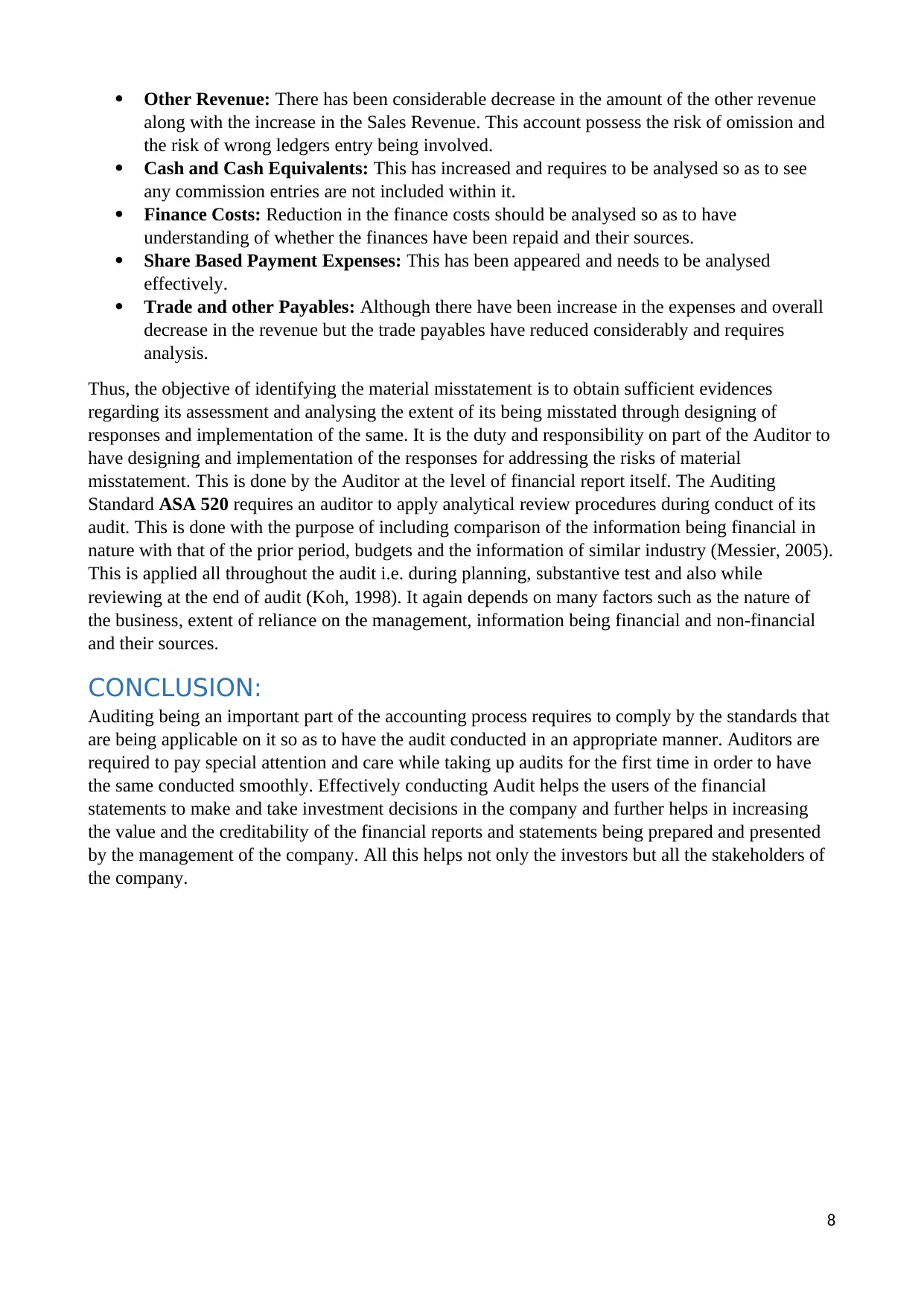
Other Revenue: There has been considerable decrease in the amount of the other revenue
along with the increase in the Sales Revenue. This account possess the risk of omission and
the risk of wrong ledgers entry being involved.
Cash and Cash Equivalents: This has increased and requires to be analysed so as to see
any commission entries are not included within it.
Finance Costs: Reduction in the finance costs should be analysed so as to have
understanding of whether the finances have been repaid and their sources.
Share Based Payment Expenses: This has been appeared and needs to be analysed
effectively.
Trade and other Payables: Although there have been increase in the expenses and overall
decrease in the revenue but the trade payables have reduced considerably and requires
analysis.
Thus, the objective of identifying the material misstatement is to obtain sufficient evidences
regarding its assessment and analysing the extent of its being misstated through designing of
responses and implementation of the same. It is the duty and responsibility on part of the Auditor to
have designing and implementation of the responses for addressing the risks of material
misstatement. This is done by the Auditor at the level of financial report itself. The Auditing
Standard ASA 520 requires an auditor to apply analytical review procedures during conduct of its
audit. This is done with the purpose of including comparison of the information being financial in
nature with that of the prior period, budgets and the information of similar industry (Messier, 2005).
This is applied all throughout the audit i.e. during planning, substantive test and also while
reviewing at the end of audit (Koh, 1998). It again depends on many factors such as the nature of
the business, extent of reliance on the management, information being financial and non-financial
and their sources.
CONCLUSION:
Auditing being an important part of the accounting process requires to comply by the standards that
are being applicable on it so as to have the audit conducted in an appropriate manner. Auditors are
required to pay special attention and care while taking up audits for the first time in order to have
the same conducted smoothly. Effectively conducting Audit helps the users of the financial
statements to make and take investment decisions in the company and further helps in increasing
the value and the creditability of the financial reports and statements being prepared and presented
by the management of the company. All this helps not only the investors but all the stakeholders of
the company.
8
along with the increase in the Sales Revenue. This account possess the risk of omission and
the risk of wrong ledgers entry being involved.
Cash and Cash Equivalents: This has increased and requires to be analysed so as to see
any commission entries are not included within it.
Finance Costs: Reduction in the finance costs should be analysed so as to have
understanding of whether the finances have been repaid and their sources.
Share Based Payment Expenses: This has been appeared and needs to be analysed
effectively.
Trade and other Payables: Although there have been increase in the expenses and overall
decrease in the revenue but the trade payables have reduced considerably and requires
analysis.
Thus, the objective of identifying the material misstatement is to obtain sufficient evidences
regarding its assessment and analysing the extent of its being misstated through designing of
responses and implementation of the same. It is the duty and responsibility on part of the Auditor to
have designing and implementation of the responses for addressing the risks of material
misstatement. This is done by the Auditor at the level of financial report itself. The Auditing
Standard ASA 520 requires an auditor to apply analytical review procedures during conduct of its
audit. This is done with the purpose of including comparison of the information being financial in
nature with that of the prior period, budgets and the information of similar industry (Messier, 2005).
This is applied all throughout the audit i.e. during planning, substantive test and also while
reviewing at the end of audit (Koh, 1998). It again depends on many factors such as the nature of
the business, extent of reliance on the management, information being financial and non-financial
and their sources.
CONCLUSION:
Auditing being an important part of the accounting process requires to comply by the standards that
are being applicable on it so as to have the audit conducted in an appropriate manner. Auditors are
required to pay special attention and care while taking up audits for the first time in order to have
the same conducted smoothly. Effectively conducting Audit helps the users of the financial
statements to make and take investment decisions in the company and further helps in increasing
the value and the creditability of the financial reports and statements being prepared and presented
by the management of the company. All this helps not only the investors but all the stakeholders of
the company.
8
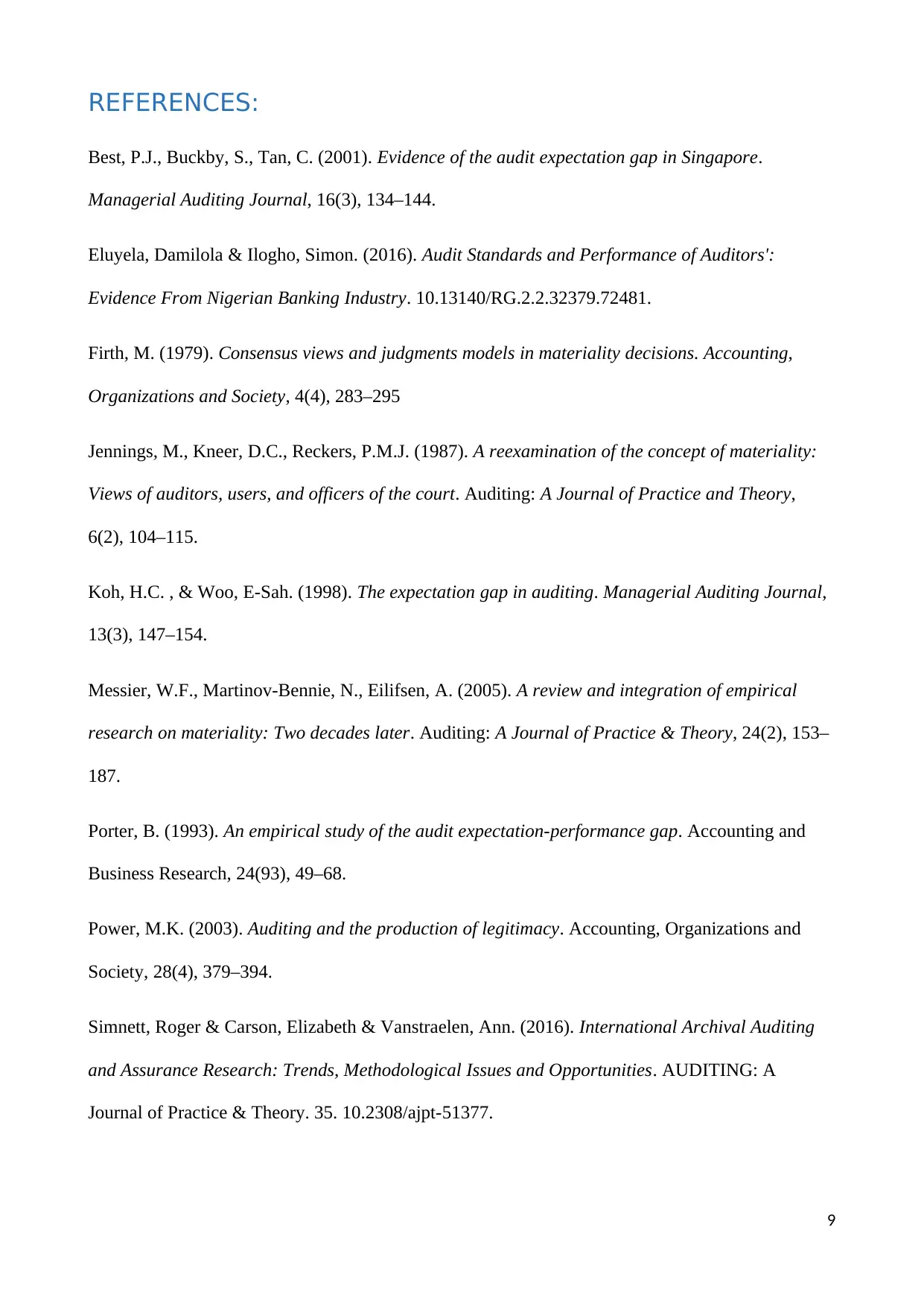
REFERENCES:
Best, P.J., Buckby, S., Tan, C. (2001). Evidence of the audit expectation gap in Singapore.
Managerial Auditing Journal, 16(3), 134–144.
Eluyela, Damilola & Ilogho, Simon. (2016). Audit Standards and Performance of Auditors':
Evidence From Nigerian Banking Industry. 10.13140/RG.2.2.32379.72481.
Firth, M. (1979). Consensus views and judgments models in materiality decisions. Accounting,
Organizations and Society, 4(4), 283–295
Jennings, M., Kneer, D.C., Reckers, P.M.J. (1987). A reexamination of the concept of materiality:
Views of auditors, users, and officers of the court. Auditing: A Journal of Practice and Theory,
6(2), 104–115.
Koh, H.C. , & Woo, E-Sah. (1998). The expectation gap in auditing. Managerial Auditing Journal,
13(3), 147–154.
Messier, W.F., Martinov-Bennie, N., Eilifsen, A. (2005). A review and integration of empirical
research on materiality: Two decades later. Auditing: A Journal of Practice & Theory, 24(2), 153–
187.
Porter, B. (1993). An empirical study of the audit expectation-performance gap. Accounting and
Business Research, 24(93), 49–68.
Power, M.K. (2003). Auditing and the production of legitimacy. Accounting, Organizations and
Society, 28(4), 379–394.
Simnett, Roger & Carson, Elizabeth & Vanstraelen, Ann. (2016). International Archival Auditing
and Assurance Research: Trends, Methodological Issues and Opportunities. AUDITING: A
Journal of Practice & Theory. 35. 10.2308/ajpt-51377.
9
Best, P.J., Buckby, S., Tan, C. (2001). Evidence of the audit expectation gap in Singapore.
Managerial Auditing Journal, 16(3), 134–144.
Eluyela, Damilola & Ilogho, Simon. (2016). Audit Standards and Performance of Auditors':
Evidence From Nigerian Banking Industry. 10.13140/RG.2.2.32379.72481.
Firth, M. (1979). Consensus views and judgments models in materiality decisions. Accounting,
Organizations and Society, 4(4), 283–295
Jennings, M., Kneer, D.C., Reckers, P.M.J. (1987). A reexamination of the concept of materiality:
Views of auditors, users, and officers of the court. Auditing: A Journal of Practice and Theory,
6(2), 104–115.
Koh, H.C. , & Woo, E-Sah. (1998). The expectation gap in auditing. Managerial Auditing Journal,
13(3), 147–154.
Messier, W.F., Martinov-Bennie, N., Eilifsen, A. (2005). A review and integration of empirical
research on materiality: Two decades later. Auditing: A Journal of Practice & Theory, 24(2), 153–
187.
Porter, B. (1993). An empirical study of the audit expectation-performance gap. Accounting and
Business Research, 24(93), 49–68.
Power, M.K. (2003). Auditing and the production of legitimacy. Accounting, Organizations and
Society, 28(4), 379–394.
Simnett, Roger & Carson, Elizabeth & Vanstraelen, Ann. (2016). International Archival Auditing
and Assurance Research: Trends, Methodological Issues and Opportunities. AUDITING: A
Journal of Practice & Theory. 35. 10.2308/ajpt-51377.
9
⊘ This is a preview!⊘
Do you want full access?
Subscribe today to unlock all pages.

Trusted by 1+ million students worldwide
1 out of 9
Related Documents
Your All-in-One AI-Powered Toolkit for Academic Success.
+13062052269
info@desklib.com
Available 24*7 on WhatsApp / Email
![[object Object]](/_next/static/media/star-bottom.7253800d.svg)
Unlock your academic potential
Copyright © 2020–2025 A2Z Services. All Rights Reserved. Developed and managed by ZUCOL.




